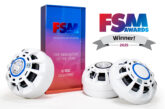
New legislation, the recent revision to BS 8629 and the HSE’s ‘Be Ready’ campaign are set to accelerate demand for evacuation alert systems. Here C-TEC’s Business Development Manager, Andy Turner, examines the current climate and focuses on a cluster of projects where evacuation alert systems are being used to protect people should stay-put fail.
In the aftermath of the Grenfell Tower disaster, the Scottish government quickly brought in a law requiring manual evacuation systems to be installed in new residential buildings taller than 18 metres. This meant a standard was needed to ensure these systems would be effective, so BS 8629 was written so it would be available when the law came into effect.
Following this, the Grenfell Tower Inquiry phase 1 report was published, which recommended that evacuation systems should be installed in all new and existing high-rise residential buildings. Demand has also been fuelled by the new amended Part B of the Building Regulations which came into force on 1 December 2022. This states that evacuation alert systems must be fitted in all new high-rise residential buildings over 18 m in England.
The HSE’s ‘Be Ready’ campaign calls on the 12,500 high-rise residential buildings across England to register with the Building Safety Regulator and appoint a ‘responsible person’. The move to increase resident safety in tower blocks by informing owners and managers of their legal duties and the recent revision of BS 8629 are likely to intensify interest in the evacuation of tall buildings.
What is an evacuation alert system?
Evacuation alert systems are manually controlled alarms that allow the Fire and Rescue Service (FRS) to set off sounders in groups of flats, usually a floor at a time, to alert residents to evacuate.
However, the FRS will only use the system if it lacks resources to fight a fire effectively or if a fire is getting out of control, so it’s a system of last resort that may only be used hours after a fire first starts. This is in contrast to a normal fire alarm system, which incorporates automatic fire detectors and operates as soon as a fire is detected.
As one of the first manufacturers to design an evacuation alert system, C-TEC has been at the forefront of the new technology’s roll out in the UK. We specifically designed EVAC-ALERT so it can easily be customised to create a cost-effective BS 8629-compliant solution in any high-rise building.
Case study: London calling
An excellent example of how the system is currently being utilised is a seven high-rise residential tower block project in the heart of London. Guinness Square in Southwark and the Houses of Aubin, Clemoes, Maitland, Sherratt, Southgate and Sweeting in Brixton’s Loughborough Park are all managed by The Guinness Partnership. The upgrading of the life safety systems was deemed vital to ensure the protection of residents living in the properties.
Orestone Controls, the BAFE SP203 and SP207-accredited specialist systems integrator, was tasked with equipping the blocks with fully BS 8629 compliant evacuation alert systems to assist the Fire and Rescue Service (FRS) in evacuating part, or all, of a building in an emergency.
Ryan Mullen, Orestone’s CCO, said: “Demand for evacuation systems is at an all-time high due to a combination of improved fire safety standards and new legislation. We’ve noticed an increase in enquiries and orders since the new Part B of the Building Regs came in last year while the HSE ‘Be Ready’ campaign will also no doubt trigger new contracts with local councils and private companies over the next six months.”
He added: “We chose to specialise in EVAC-ALERT primarily for the ‘handholding’ service C-TEC provides, namely the first-class technical support that is so important on life-safety system projects. From the first demonstration of EVAC-ALERT at our offices, to where we are today, C-TEC has supported us and our relationship has gone from strength-to-strength.
“We’re experts at installation, highly conversant with the standards, and because of this we’ve had to expand our fire division again with additional dedicated engineers to deal with growing demand. We’ve also started to work for other Housing Associations including GreenSquare Accord on some of their high-rise buildings.”
As BS 8629 is a relatively new standard, C-TEC is very keen to ensure we educate people about its requirements. Throughout a project, we’re there to make life easier for the client – be that the consultant, the installer, the owner or building management company – and we can assist with plans, technical drawings and the loop calculations required.
System design
By using the unique evacuation alert system software created by our R&D team and undertaking an assessment of a building, we can calculate exactly which devices are required. Special requirements for elderly, vulnerable and disabled residents are also taken into consideration. We also provide completely free advice and training on commissioning, cause and effects and any other issues the customer may have.
Ryan added: “Our engineers are constantly expressing how simple and intuitive EVAC ALERT is to install. The wiring is very straightforward and the flat interface units give you confidence that any short circuits will be isolated, protecting the integrity of the loops. There’s no doubt that the system’s simplicity has allowed us to achieve minimal disruption to residents and work around their busy lives, as we can be in and out of each flat in under an hour.
“Customer satisfaction is very important to Orestone and we consistently score five out of five on reviews. We take time to engage with residents and explain how the systems we’re installing are designed to protect them. At Guinness Square we even held a joint open day with The Guinness Partnership to showcase the technology to residents, which the London Fire Brigade also attended.”
Peace of mind
The systems in each high-rise typically consist of 2-loop control panels connected to a host of single and multi-way interface units, self-testing sounders and visual indicators. Simple and intuitive, with manual controls to allow firefighters to easily operate the evacuation alert devices located inside flats on a floor-by-floor basis, the panel is stored in a secure vandal resistant cabinet which can only be accessed by the FRS using a special copy-protected key.
Peace of mind that there is a ‘Plan B’ if everything else goes wrong is crucial in the current climate, not just for owners and residents, but also for the fire service. By installing an evacuation alert system, building management can be confident that every precaution possible has been taken to protect the people residing in the property.
Certified to all relevant EN 54 product standards, EVAC-ALERT is powered by C-TEC’s CAST protocol and fully compatible with ENVISION, our powerful new Cloud-based fire alarm remote access, service and site management software package which can be used to provide duty holders with a verifiable audit trail of system activity and device testing.
Watch a video demo of the EVAC ALERT System from C-TEC here












